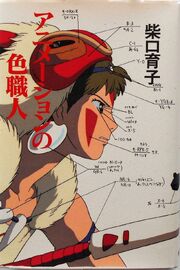Michiyo Yasuda (保田 道世, Yasuda Michiyo, April 28, 1939 – October 5, 2016) was an animator and color designer who worked for Toei Animation, A Production, Nippon Animation, TopCraft, and Studio Ghibli.
Her designs were used by directors such as Isao Takahata, Hayao Miyazaki and Mamoru Oshii. During a career spanning five decades in the animation industry, she worked on animated feature films and short films for theatrical release, original video animation (OVA), promotional music videos, animated television series, documentaries and commercials.
She officially retired after working on Ponyo in 2008, but worked on the Academy Award nominated animated feature The Wind Rises, released in July 2013. She made an appearance on The Kingdom of Dreams and Madness while her death was referenced in Never-Ending Man: Hayao Miyazaki.
Her biography, The Color Artisan of Animation (アニメーションの色職人 , Animeeshon no Iroshokunin), authored by Yasuko Shibaguchi, was published by Tokuma Shoten in June 1997.[1] She was again featured on Masahiro Ioka Illustration Portfolio (井岡雅宏画集 , Ioka Masahiro Gashuu), published on April 30, 2001.[2]
History[]
Early life[]

Yasuda, referred to affectionately as "Yacchin" by Hayao Miyazaki at her work station.
Born in Tokyo's Nakano ward, Yasuda grew up in the Tokyo metropolitan area. For most of her childhood and adolescence she lived in Higashi-fushimi, a neighborhood in what became Nishitōkyō city as of 2001. Her father was a university professor, and she grew up with an older brother, an older sister and three younger brothers. She has described her youth as very pleasant with a lot of freedom and mentioned getting encouragement to excel in any field. She received an education in culture and the arts at school and at home.
When she was 14 years old her parents divorced. In November 1954 her father fell ill and, in spite of their divorce, was nursed by her mother until his death in March 1955. In April 1955 Yasuda enrolled in Tokyo Metropolitan Shakujii High School [ja]. Without the opportunity to continue into higher education she started looking for a job to support herself.
Career[]

Yasuda provided detailed color instructions, as most of the coloring of cels was outsourced.
Yasuda joined Toei Animation in April 1958, immediately after her graduation from high school. Yasuda has said that she applied not knowing what the job entailed but that she had submitted her application because she did not fancy employment in any of the other jobs available for most women at the time, such as bank teller or store clerk. Instead she took the opportunity to work in a creative field.[3] She started out in the Toei finishing department, in the ink and paint section, where she worked on TV series and commercials as a tracer. In traditional animation a tracer is a person whose job involves transferring cleaned up line drawings onto the cels. Through her work and union activities at the company she made the acquaintance of Isao Takahata and Hayao Miyazaki whose careers also began at Toei, joining in 1959 and 1963 respectively.

Rikka Ihara played Momoyo Morita, a stand-in for Yasuda in the NHK morning drama Natsuzora.
Yasuda also worked as a tracer on Hols: Prince of the Sun, directed by Takahata, for which Yasuo Ōtsuka was animation director and Miyazaki was one of the key animators. They built lasting working relationships that endured for over 40 years. After leaving Toei, Yasuda next joined A Production followed by Nippon Animation where she worked in the finishing department on productions such as 3000 Leagues in Search of Mother. On the animated TV series Future Boy Conan, aired in Japan in 1978, she was in charge of color selection for an entire project for the first time. This position involved her choosing color for all the items and characters seen in motion throughout the animated work.
In the 80's she continued to work on titles such as Lucy of the Southern Rainbow (1982 TV series), The Many Dream Journeys of Meme (1983 TV series), Angel's Egg (1985 OAV), and Devilman (1987 OAV).[4]

The cover of Yasuda's memoir The Color Artisan of Animation, published in 1997.
In 1983, she worked for TopCraft and was in charge of color design on the adaptation of Miyazaki's manga Nausicaä of the Valley of the Wind into the animated feature film of the same title. The film was released in Japanese theaters on March 11, 1984. The collaborations culminated in the creation of Studio Ghibli in June 1985.
Yasuda worked with Mamoru Oshii on his 1985 OVA Angel's Egg released in December 1985. She took charge of Studio Ghibli's color department from its inception for the creation of the Castle in the Sky production and collaborated with various directors and animators in the creation of nearly all Studio Ghibli animation works until her retirement. She last worked on the feature films Ponyo and The Wind Rises and in between on the short Mr. Dough and the Egg Princess for the Ghibli Museum in Mitaka.

Yasuda was one of Miyazaki's closest collaborators. She encouraged him to continue filmmaking after his retirement.
Throughout most of her career Yasuda worked on color designs for animators who employed the use of inks and paints for their creations but she also worked with digital media and used software like Toonz for her craft. At Studio Ghibli, Yasuda decided colors in consultation with Miyazaki and let the depicted objects guide her choices, based on the availability of materials and dyes in the time period portrayed. Her choice of individual colors and a color scheme was also determined based on the mood of each film, a particular scene and the personality of each individual character. In the Los Angeles Times Cristy Lytal observed: "For Yasuda, color is a storytelling tool that is every bit as powerful as words".

Yasuda in later life.
In the article, Lytal quotes Yasuda, saying: "What I like best is when I am building up the colors in my head, thinking of how to get the tone worked out," and "Color has a meaning, and it makes the film more easily understood. Colors and pictures can enhance what the situation is on screen." In their book Anime Classics Zettai!, Brian Camp and Julie Davis made note of Yasuda as a "mainstay of Studio Ghibli’s extraordinary design and production team".
Yasuda died on October 5, 2016, at the age of 77.
References[]
- ↑ "The Color Artisan of Animation", Nausicaa
- ↑ "Masahiro Ioka Illustration Portfolio", Nausicaa
- ↑ "The Color Artisan of Animation", Yasuko Shibaguchi
- ↑ "Michiyo Yasuda Profile", Nausicaa
External links[]
 Michiyo Yasuda at the Internet Movie Database
Michiyo Yasuda at the Internet Movie Database  Michiyo Yasuda on Anime News Network
Michiyo Yasuda on Anime News Network Michiyo Yasuda on Wikipedia
Michiyo Yasuda on Wikipedia
[]
| |||||||||||||||||||
